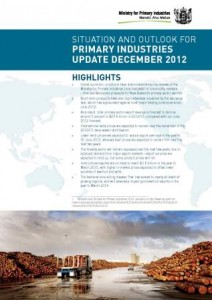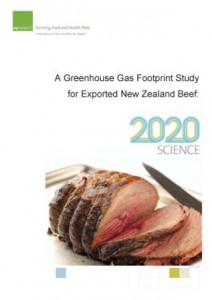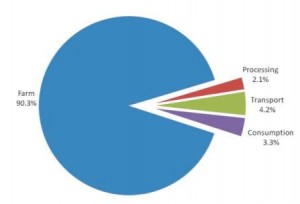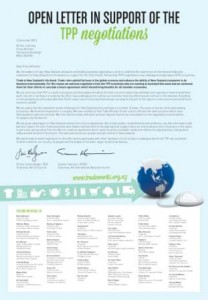Chef Graham Brown demonstrates how to make a delicious farm-raised venison stroganoff. Enjoy!

Chef Graham Brown demonstrates how to make a delicious farm-raised venison stroganoff. Enjoy!

Ministry for Primary Industries deputy director-general standards Carol Barnao (left) and US Food and Drug Administration deputy commissioner for food Michael R Taylor sign a systems recognition agreement at a meeting in Washington DC.
New Zealand this week became the first country in the world to sign an agreement with the US Food and Drug Administration (FDA) that recognises each other’s food safety systems as providing a comparable degree of food safety assurance.
Meat exporters will welcome the move, which will enable
streamlining of product to the market – New Zealand’s top destination for beef, fifth largest for venison and fourth largest for lamb – through the reduction of red tape and costs.
The Food Safety Systems Recognition Arrangement was signed at a meeting in Washington DC by delegations from the Ministry for Primary Industries (MPI) and FDA.
“This is momentous for MPI as it is the first time the FDA has recognised another country’s food safety system as comparable to its own,” says MPI deputy director-general standards, Carol Barnao.
“The arrangement with New Zealand is part of an overall strategy for strengthening the global food safety net through closer collaboration with regulators around the world, highlighted in FDA’s report Pathway to Global Product Safety and Quality,” FDA’s Deputy Commissioner for Food Michael R Taylor says.
Carole Barnao says both countries have done a huge amount of work ahead of this week’s signing.
“This process has included a comprehensive review of each country’s relevant laws and regulations, inspection programmes, response to food-related illness and outbreaks, compliance and enforcement and laboratory support.
“In one calendar year, FDA and New Zealand officials spent an intensive period of time together including visiting production plants, cold-store facilities, verifiers and accreditation authorities looking at the effectiveness of how each other’s preventative controls and verification systems worked.”
Barnao explains that both countries intend to use the agreement to lessen the potential regulatory burden for foods traded between the countries by removing unnecessary duplication of activities.
The agreement covers all foods and animal feeds regulated by the FDA, which equates to $1.5 billion of New Zealand’s current exports of primary products.
“Systems recognition agreements are very important for MPI to help us achieve one of our key strategic goals of maximising export opportunities through other countries’ recognition of the credibility of our food safety controls,” Barnao says.
 New Zealand’s meat processors and farmers can expect lower lamb prices over the remainder of the 2012/2013 production season, while beef prices are expected to remain firm over the next two years, says the Ministry of Primary Industries (MPI).
New Zealand’s meat processors and farmers can expect lower lamb prices over the remainder of the 2012/2013 production season, while beef prices are expected to remain firm over the next two years, says the Ministry of Primary Industries (MPI).
Deteriorating global economic conditions are having a significant impact on returns for New Zealand’s primary produce, according to the MPI’s recently released half-year update to the annual Situation and Outlook for Primary Industries report, which was published in June.
The update shows there has been strong pastoral production so far in the 2012/2013 season. “This is partly due to favourable climatic conditions during the previous season which left breeding stock in good condition and also ongoing expansion of the dairy herd,” says Chris Jones, manager of economic information and analysis for MPI’s sector policy division.
However, MPI reports the continuing economic slowdown, particularly in the traditional markets of the European Union, is causing weaker demand for some products such as lamb resulting in lower lamb prices. In addition, the strengthening of the New Zealand dollar against most major trading currencies in recent months is having a dampening effect on farm-gate returns for primary produce.
In contrast, beef prices are expected to remain firm over the next two years, following a major drought in North America affecting production there.
As a result, primary sector export revenue for the year to June 2013 is forecast to be around $27.5 billion, down five percent on the previous year ($29.2 billion).
‘New fashioned values’ are emerging in British shoppers in these difficult economic times, according to new research from leading retailer Sainsbury’s.
Having to think more carefully and thoughtfully about household spending, especially on food has triggered a set of new, positive shopping behaviours across all socio-economic groups, says a blog on the retailer’s website.
“Our research shows a deep and widespread change has taken place with 83 percent of Sainsbury’s shoppers having changed their shopping habits in the last year.”
Shoppers are “rediscovering habits of previous generations” – making shopping lists, planning weekly meals, being creative with leftovers and preparing packed lunches. More people are choosing bargains and basic products for everyday needs, but are “enjoying the sense of deferred indulgence that comes from saving up and splashing out on special occasions.”
Sainsbury’s research has also shown that while consumers have reduced their spending, “they actually care more” with quality, integrity and sustainability increasingly becoming the drivers that shape shopping choices, as well as prudence.
“These ‘new fashioned values’ are not a passing phase but represent a fundamental change that is here to stay,” says Sainsbury’s, adding that it launched its 20×20 Sustainability Plan a year ago. The retailer believes its commercial success will continue to depend on continuing to meet and anticipate its customers’ changing needs.
“We can’t do this alone and need the industry, our suppliers and other experts to radically re-examine our ways of doing things, to help meet some of our targets such as doubling the amount of British food we sell and increasing the sales of fairly traded products to £1 billion.”
Market researchers Mintel had analysed Sainsbury’s customer behaviour and reported the findings. The result, a factsheet ‘The rise of new fashioned values’, shows that the results span all socio-economic demographics. The research showed that 83 percent of people have changed their shopping habits in response to squeezed family budgets and that fairness to employees, waste and Britain remain similar to last year.
The factsheet shows Sainsbury’s has identified five characteristics of ‘new-fashioned’ values:
It also covers how Sainsbury’s is meeting the needs of the new-fashioned shopper, through helping consumers to live the way they want to live and making it easier for them to buy what they need. Making sure customers can be confident about the quality, value and integrity of the products, irrespective of price or range.
 After Allan Barber’s column last week about meat industry debt levels, Keith Cooper, chief executive of Silver Fern Farms, took him to task for incorrectly reporting the situation with Silver Fern Farms’ debt facility, he writes in his latest guest blog.
After Allan Barber’s column last week about meat industry debt levels, Keith Cooper, chief executive of Silver Fern Farms, took him to task for incorrectly reporting the situation with Silver Fern Farms’ debt facility, he writes in his latest guest blog.
I stated that these expired in September 2012 and therefore the company was operating on a temporary extension. The correct position was that the debt facility was originally negotiated for two years from September 2010 and consequently due to expire in September 2012. This remained the position at balance date in September 2011. However in the 2012 annual report, the facility was stated as expiring on 31 December 2012.
Clearly, the company had arranged a three month extension at some point before the original two year facility expired and this was not a temporary facility, as I implied. Nevertheless, it was no more than a three month extension, while the next longer term arrangement was being negotiated.
I apologise for any incorrect interpretation, but still maintain the company’s current debt level at balance date was higher than could be considered comfortable.
However, in an interview with Jamie Mackay on the Farming Show last week, when asked to comment on the industry’s debt level, Cooper gave his opinion that the debt was a good thing. Because it was tied up in inventories, it would ensure the industry acted responsibly. This is almost exactly what I wrote last week, although I saw the discipline on the companies as a necessity, not a virtue.
In Cooper’s radio interview, he stated after record prices last year, meat companies are reining things in.
“It’s a damn good thing we do have stock in store and we do have high debt because that means meat companies are acting responsibly, and are feeding the product to market to create stability of price. I’m quite happy that us and other companies have debt because that means they’ve got stock in store and that means we’re managing markets well.”
I must give Keith credit for being unreservedly a ‘glass half full’ kind of guy which you have to be to survive in what I believe is New Zealand’s toughest industry. He promises farmers that things will improve.
“We are living in volatile times. There will be volatility, but through the volatility we will see a steady increase in the price we will receive from offshore,” and he expects meat companies will pay farmers around 90 dollars per lamb this year.
I’m not sure the glass is quite as half full as Keith Cooper suggests, especially in the sheep meat market. Although lamb leg prices in the UK are holding fairly well, especially for chilled product, prices for middle cuts, like racks, loins and tenderloins, in North America and Europe are under pressure.
The price of loins and tenderloins have dropped by as much as 30 percent in the last couple of months, while there are fears of another collapse in lamb rack prices because of competition from low priced Australian product. As a result, importers are not placing orders for New Zealand lamb, because they remember the last time prices collapsed.
The Middle East has gone quiet on lamb shoulders because of cheaper Australian product, although China is still firm. Here, it appears New Zealand exporters benefit from less Australian competition with fewer China licensed plants in Australia.
All this explains why the New Zealand consumer is able to buy plenty of well priced lamb available on the domestic market. But this won’t provide more than a minimal contribution to managing the existing inventory levels and it certainly won’t cope with next year’s peak production. The industry will be keeping its fingers and toes crossed for an early economic uplift in our main markets, UK, Europe and North America, because otherwise the glass won’t have much in it at all.
Allan Barber is an agribusiness commentator, with particular interest in the meat industry. He has his own blog Barber’s Meaty Issues. This item has also appeared at www.interest.co.nz.
 Meat Industry Association (MIA) chief executive Tim Ritchie says that his organisation had supported the study because sustainability is still a critical issue in important markets.
“While it is possibly not as front-of-mind in markets as it was two or three years ago, sustainability remains very important and greenhouse gas emissions are a key component of sustainability.”
The study has created a benchmark for understanding where greenhouse gas (GHG) emissions are occurring across the beef supply chain, including production, processing, transportation and consumption.It has found that the majority (over 90 percent) of emissions occur on the farm. The footprint varies depending on the type of farm, the sex and age of the animals and whether or not animals from the dairy industry are used.
Overall, the weighted New Zealand average GHG emissions from beef animals from sheep and beef farms was 10.5kg CO2-equvalents (CO2-e) per kg of liveweight.Emissions arising from transport to market are extremely low.
Transport accounts for 4.2 percent of emissions, the report shows. In particular, oceanic shipping is very efficient and this study shows it contributes just 1.1-2.7 percent of the total carbon footprint.In addition, consumption accounts for 3.3 percent of emissions whi
Meat Industry Association (MIA) chief executive Tim Ritchie says that his organisation had supported the study because sustainability is still a critical issue in important markets.
“While it is possibly not as front-of-mind in markets as it was two or three years ago, sustainability remains very important and greenhouse gas emissions are a key component of sustainability.”
The study has created a benchmark for understanding where greenhouse gas (GHG) emissions are occurring across the beef supply chain, including production, processing, transportation and consumption.It has found that the majority (over 90 percent) of emissions occur on the farm. The footprint varies depending on the type of farm, the sex and age of the animals and whether or not animals from the dairy industry are used.
Overall, the weighted New Zealand average GHG emissions from beef animals from sheep and beef farms was 10.5kg CO2-equvalents (CO2-e) per kg of liveweight.Emissions arising from transport to market are extremely low.
Transport accounts for 4.2 percent of emissions, the report shows. In particular, oceanic shipping is very efficient and this study shows it contributes just 1.1-2.7 percent of the total carbon footprint.In addition, consumption accounts for 3.3 percent of emissions whi le just 2.1 percent comes from processing, which the report notes “is an area over which industry has direct control and where technologies are available to reduce emissions.”
Dr Stewart Ledgard, the lead author of the report says that until there is a globally-agreed methodology for ‘footprinting’ of meat products, it is hard to assess how New Zealand’s footprint compared to others. This study used the Life Cycle Assessment approach, which is consistent with the PAS2050 published standard for GHG footprinting.The beef study was undertaken by AgResearch and funded by the Meat Industry Association, Ballance Agri-Nutrients, Landcorp and the Ministry for Primary Industries greenhouse gas footprinting strategy. B+LNZ Ltd and individual meat processors provided data and information for the study. This adds to a study already completed on New Zealand lamb’s carbon footprint in 2010.
le just 2.1 percent comes from processing, which the report notes “is an area over which industry has direct control and where technologies are available to reduce emissions.”
Dr Stewart Ledgard, the lead author of the report says that until there is a globally-agreed methodology for ‘footprinting’ of meat products, it is hard to assess how New Zealand’s footprint compared to others. This study used the Life Cycle Assessment approach, which is consistent with the PAS2050 published standard for GHG footprinting.The beef study was undertaken by AgResearch and funded by the Meat Industry Association, Ballance Agri-Nutrients, Landcorp and the Ministry for Primary Industries greenhouse gas footprinting strategy. B+LNZ Ltd and individual meat processors provided data and information for the study. This adds to a study already completed on New Zealand lamb’s carbon footprint in 2010.
More reading: see ‘A Greenhouse Gas Footprint Study for Exported New Zealand Beef’, M Lieffering, S Ledgard, M Boyes & R Kemp, February 2012.
This article appeared in Food NZ magazine (December 2012/January 2013).The first New Zealand meat industry appointments to the international Fats and Protein Research Association (FPRF) were made recently.
 Graham Shortland, chief executive of Waitoa-based Wallace Corporation, is now a director of the Foundation, while meat scientist Mike North, formerly with AgResearch and now project manager for Taranaki Bio Extracts, has been appointed to the FPRF research committee.
Graham Shortland, chief executive of Waitoa-based Wallace Corporation, is now a director of the Foundation, while meat scientist Mike North, formerly with AgResearch and now project manager for Taranaki Bio Extracts, has been appointed to the FPRF research committee.
Shortland believes that this is a “super opportunity” for the New Zealand and Australian rendering industry to be directly involved in and influence a very credible organisation. “I’m looking forward to taking up the role,” he says.
The US-based FPRF sponsors research on rendered products to enhance current usage and also to develop new uses.
Rendering is an important contributor to revenues for the New Zealand meat industry, producing value-added products, tallow and bone meal (see Food NZ February/March 2010) and also mitigating greenhouse gas emissions. Exports of both products to the year end June 2012 were worth $308 million. Tallow exports grew in value by $16 million to $169 million, with volume rising 15,710 tonnes to 134,177 tonnes, with China taking over two-thirds of the exported product. While the value of meat and bone meal exports – primarily to Indonesia and the US – grew by $10 million to $139 million, the volume fell slightly, by just over 3,000 tonnes, on the previous year to 145,563 tonnes.
Both Wallace Corporation and Taranaki Bio Extracts are members of the Meat Industry Association (MIA)’s Renderers’ Group, which recently received New Zealand Trade & Enterprise funding for a market development project aiming to increase returns by selling rendered products into higher value applications and markets. Insights Shortland and North gain from their involvement with FPRF will be fed back into that project, which is now at stage one: targeted market research.
“We are now starting to see a clearer picture of where we might obtain higher returns for some of our basic commodities,” says Shortland. “The FPRF has carried out research and innovation projects that could well help us move our value-add objectives ahead more speedily.”
Offering his congratulations on their appointment, Renderers’ Group executive member Alan von Tunzelman, general manager of PVL Proteins Ltd and a past president of the World Renderers’ Organisation, said he never thought a nominee from this country would be appointed to a role in the international organisation.
“To get both appointed to the respective roles is a great tribute to how they feel about us as an organisation and as people who can contribute positively and make sensible inputs into the FPRF. This is a wonderful opportunity to advance international research and development into rendering and the great work performed by the Meat Industry Research Institute of New Zealand has a further chance of some new life.”
The Renderers Group runs training workshops, which enable experienced operators and supervisors to receive the core knowledge necessary for the National Certificate in Meat Processing (Rendering Level 4) and to build networks with others in the industry. In addition, a joint meeting for members with Australian counterparts in March gave further opportunity for international sharing of knowledge.
In consultation with members, the group published the ‘New Zealand Rendering Industry Guidelines for Managing and Assessing Odour’ last year. Copies are available from the MIA.
Find out more about FPRF at its website www.fprf.org.
This article first appeared in Food NZ (December 2012/January 2013).
Congratulations to Tony Egan’s team at Greenlea Premier Meats which, the Waikato Times informs us, recently won the Supreme Award in the 2012 Westpac Waikato Business Excellence Awards, after securing the Tompkins Wake Lawyers Award for Businesses that employ 50 or more full-time equivalent staff. Read more …
 Heads of various meat industry organisations have shown their public support for the Trans Pacific Partnership (TPP) trade agreement negotiations underway in Auckland this week between eleven APEC economies.
Heads of various meat industry organisations have shown their public support for the Trans Pacific Partnership (TPP) trade agreement negotiations underway in Auckland this week between eleven APEC economies.
They are amongst more than 50 business leaders from some of New Zealand’s largest and most successful companies and business organisations to have signed an open letter to Prime Minister John Key, underlining the importance of international trade and investment for New Zealand.
Among the signatories are Alliance chief executive Grant Cuff, ANZCO Foods’ managing director Mark Clarkson, Silver Fern Farms’ Keith Cooper, Greenlea Premier Meats’ Tony Egan and Sir James Wallace chairman of Wallace Corporation alongside Meat Industry Association chairman Bill Falconer and Beef + Lamb NZ Ltd’s chairman Mike Pedersen and chief executive Scott Champion.
“The signatories to the open letter represent a cross section across all major export sectors in New Zealand, including agriculture, forestry, fishing, horticulture, wine, manufacturing, technology and Maori business. Together they either directly employ, or their members employ, an enormous number of Kiwis,” says the chairman of the New Zealand International Business Forum (NZIBF), Sir Graeme Harrison.
 “These business leaders welcome the TPP round taking place in Auckland this week and commend negotiators from the TPP economies for their efforts to conclude a future agreement which should bring benefits for all member economies”.
“These business leaders welcome the TPP round taking place in Auckland this week and commend negotiators from the TPP economies for their efforts to conclude a future agreement which should bring benefits for all member economies”.
“The group is aware the negotiation poses challenges for New Zealand policy settings in a number of areas and that the negotiation is complex. We have confidence that Trade Minister Tim Groser and his officials will seek solutions that meet New Zealand’s national interests.”
“We see great advantages for New Zealand arising from a future agreement that is high quality, comprehensive and ambitious, one that eliminates trade barriers, lowers the cost of doing business and makes improvements to the way regional supply chains can link producers and consumers in the region.”
The open letter coincides with the launch of a new business-led initiative, Trade Works, a website (www.tradeworks.org.nz) to help Kiwis better understand the benefits of trade and investment for New Zealand, and understand the potential benefits of TPP. Funding for the website has been provided by the NZ US Council and the website has been built with the support of thirteen business organisations representing the main export sectors.
“The Council and its partners see value from an effort to create a TPP which meets business and wider needs and reflects the way business is being done today and will be done in the future. This will assist economic growth and job creation in New Zealand. Our new website signals that we are also ready to participate with other members of civil society in a dialogue about how TPP can contribute to what it is best for New Zealand,” says the chairman of the NZ US Council, Rt Hon James Bolger.
 A new $87 million innovation programme that will look at how more value can be generated from beef carcases has been approved for Government funding.
A new $87 million innovation programme that will look at how more value can be generated from beef carcases has been approved for Government funding.
Ministry for Primary Industries director-general Wayne McNee today announced approved co-funding from the Primary Growth Partnership (PGP) for the new Foodplus programme.
The PGP Fund is committing $43.5 million over seven years for the programme, which is worth $87 million in total and is being run by ANZCO Foods.
Foodplus will identify opportunities to create new products, with a particular focus on parts of the beef carcase that currently generate less value. ANZCO has identified three markets for innovative new products: food, ingredients and healthcare.
ANZCO Foods is a multinational group of companies and one of New Zealand’s largest exporters, with sales of $1.3 billion and employing more than 3,000 staff worldwide. ANZCO Foods also owns processing plants and a cattle feedlot: CMP, Riverlands and Five Star Beef.
“Adding further value to the carcase is essential for the future success of the meat industry,” says McNee. “ANZCO’s vision for Foodplus is relevant and bold and now backed by a significant investment.”
Rennie Davidson, CEO of ANZCO’s Food & Solutions division says ANZCO welcomes the opportunity to partner with the Crown on the Foodplus programme. “It is a large-scale project that wouldn’t be achievable without collaboration. We’re excited about the potential that this will bring to the sector.”
This announcement brings the Government’s investment in meat industry PGP programmes to $129.5 million, for projects worth a total of over half a billion dollars.
Minister welcomes announcement
 Primary Industries Minister David Carter has welcomed the announcement of another successful PGP bid which lifts the total invested in the variety of projects to more than $650 million.
Primary Industries Minister David Carter has welcomed the announcement of another successful PGP bid which lifts the total invested in the variety of projects to more than $650 million.
“ANZCO’s proposal to generate more value from the beef carcase with its Foodplus programme is bold and innovative. This is exactly what PGP is about – transforming great ideas into tangible R&D programmes focussed on results,” says Carter.
“Today’s announcement lifts the total government-industry investment in PGP since its inception three years ago to $665 million. This is firm proof of the Government’s drive to lift economic growth through primary sector innovation.
“Thanks to the collaborative government-industry approach, we have relevant projects underway across a range of sectors from dairy, arable, red meat and wool to forestry, seafood and aquaculture and manuka honey.
“New Zealand stands to gain from innovative investment in its primary industries because our food, fibre, fishing and forestry sectors are at the heart of our economy,” says the Minister.
ANZCO Foods is a multinational group of companies and one of New Zealand’s largest exporters, with sales of $1.3 billion and employing more than 3000 staff worldwide. The company owns processing plants and a cattle feedlot within a group including CMP, Riverlands and Five Star Beef.